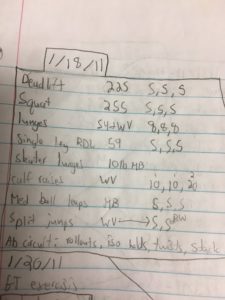My goal with this article is not to impress you with a 630lb deadlift. Honestly, it’s not that impressive. It was with a hex bar, and people have definitely done more. However, I do want to take the time to communicate the lessons I learned over that 7 and a half year process.
This picture is from my first ever workout journal entry. As you can see, it’s dated January 18th of 2011. As you can also see, I had no idea what I was doing. Deadlift and squats on the same day, plyos at the end of my workout, ab circuits. It makes me cringe. But, at least for me, there’s beauty in that. When I first started this journey, back in 2011, it was never my goal to deadlift over 600 lbs. I didn’t have it all mapped out. I knew that I wanted to play college baseball and that getting stronger was probably going to help me do that. So, I began reading everything I could get my hands on that had anything to do with training the baseball athlete. Here’s the catch: Even though I was spending 3-4 hours educating myself everyday, that didn’t mean I was going to get it right the first time. As you can see, I definitely did not. I was nowhere close to getting it right the first time. And that’s okay. Which leads us to lesson #1…
Lesson #1: Just Start
As more and more information comes out and as we get better and more precise in the training of athletes, I think there comes with it a propensity to think everything has to be perfect. And because of that, we sometimes get an influx of so much information, we don’t know what to do with it, which leads to nothing at all. Nothing will ever be perfect. When’s the last time something went exactly as planned for you? When’s the last time a baseball game went exactly as planned for you? I can pretty much guarantee never. No matter what you’re trying to do, just start. The details will work themselves out as you go.
Lesson #2: Everyfrickinday
I haven’t missed a planned workout in 7.5 years. That’s not to brag, that’s just what is. Because here’s a little secret: unless you’re one of the few genetic elite who can get by on natural talent and donuts, you will NOT be successful in your baseball career unless consistency becomes a part of your vocabulary.
I see it all the time: “I will do anything to play professional baseball”!
Cool, we’re going to lift, throw, and hit 4 times per week, plus do speed work 3 times per week. In addition, you need to track your progress in all of these areas via a journal or spreadsheet. Finally, you need to put on a few pounds so we’re going to start tracking your calories so we can get an idea for how much you need to eat per day to gain the necessary weight. And then, to make sure, we’ll be doing daily weigh-ins, which you need to track as well.
1 week in: I only lifted 3 times last week cause I had a pickup basketball game one night and I lost my journal so I don’t remember the weights but I’ll still do whatever it takes.
Gimme a break. Consistency means you have a plan, you follow that plan, you finish that plan, you evaluate the results of that plan, you adjust the plan moving forward, and you repeat that procedure with all future plans. Screaming work harder and doing whatever you feel like doing everyday because you’re special and different than everyone else is a lazy way of saying the actual process of improvement is too hard and you don’t want to put in that much emotional effort so you do whatever sounds good for the day. It might feel good in the moment, but that’s not an avenue that’s going to lead to continued improvement or success.
Lesson #3: Levels
There are levels to everything. For deadlifting, it goes like this:
-Learn the exercise, perform the exercise.
-Learn there’s a right way to do the exercise.
-Obsess over doing the exercise correctly: Foot width, setup, neck tucked, etc. During this level, it’s likely ALL aspects of the deadlift will be over exaggerated at some point.
-Master the exercise: You’ve learned and executed all aspects of the deadlift correctly, you can now perform it correctly and at a high level without thinking about it.
-Experimentation: You know the exercise, and how you respond to it, so well that you can start implementing your own twist on how you train the exercise. This is where it gets fun.
The above levels/process can be applied to just about anything you are trying to do. I think this quote from Steve Jobs applies:
“Simple can be harder than complex: You have to work hard to get your thinking clean to make it simple. But it’s worth it in the end because once you get there, you can move mountains”.
In the beginning, whatever it is you are trying to achieve seems simple. “I want to play college baseball. All I have to do is be good enough to compete on a college team”. Later, as you move through the process, things get more complex. You need to meet certain baselines in terms of throwing, hitting, running, and defensive ability. You need to be able to handle pressure. Etc. You learn there are many things that go into your original goal. However, as that goal is achieved, and then surpassed, you look back and the goal has become simple again. Really all you had to do was be good enough to play college baseball. You understand all the complexities that fall within that, and can make it simple again.
So always know there are levels and there is almost always another level you have not yet reached. I know that’s true for you as well as me. Always strive for that next step.
Lesson #4: Baseball Isn’t all about Strength
Surprise: my exit velo, my throwing velo, etc went up corollary with my strength till I reached about 465 on the deadlift. After that, I had to look into other measures to get my actual baseball numbers to go up. These included mechanical efficiencies, training volume and intensity, etc. Just because I deadlifted 630 doesn’t mean you have to as well. Stronger doesn’t always mean better. Instead, get a baseline of strength, and then maintain that strength while working on other qualities. Lifting is not our sport. It’s an element of training for our sport. Don’t be like me and get strong while forgetting to actually get good (or better) at your sport.
Final Thoughts:
There were some interesting points along the way on what turned out to be my “journey to 600 lbs”. I once gave myself a neck crick (is that the right word?) for 3 days from looking sideways in the mirror trying to make sure my spine was neutral. Little did I know, your cervical spine is an important piece of the spine and looking sideways while deadlifting heavy is probably not the best idea.
I once trained for two months straight by going up to a 1RM on deadlift, squat, DB BP and 3RM on DB row, 5 times per week. Literally the same 4 exercises everyday, up to a max, for 2 months. I actually loved it, and put 50 lbs on my deadlift during that time (415 to 465), but would not recommend this as the most optimal process athletes use for getting stronger.
I once stopped deadlifting completely and ONLY maxed on squat everyday, eventually working up to maxing out on squats THREE times per day. Needless to say, within a week or two, my hips said no and it took a good 6 months before I was able to get full hip flexion again (I was on a John Broz/Bulgarian kick at the time, in case you were wondering).
All of this to say… no journey will ever be perfect. But that’s the beauty of it. Imperfect journeys are what create growth. Without mistakes, without mess-ups, without putting a crick in your neck because you didn’t know your neck was part of your spine, you will never progress to new levels. I’m not saying you need to make all these mistakes on your own. Quite the opposite. You should take and learn everything you can from the mistakes I’ve made and from the mistakes others have made as well. Combine those with your own experience and knowledge, and you’ve got a much improved process with which you can move forward with.
Be consistent. Strive to level up. And, most importantly, just start.
For fun, here’s the video of the 630 lb deadlift. I weighed in at 187 lbs on this particular day:
That’s all I got for today. Thanks for reading.
Have questions or comments? Interested in training with DAC? I can be reached via email at brady@dacbaseball.com.

